Overview
- Description
- Consists of five issues (Jan 4, 11, 18, 25; Feb 1, 1945) of the Jewish review. Among the topics discussed in the various articles are racism, Jewish personalities, conditions of Jews in Europe during World War II, and Palestine.
Physical Details
- Extent
-
1 folder
- System of Arrangement
- Arrangement is chronological
Rights & Restrictions
- Conditions on Access
- There are no known restrictions on access to this material.
- Conditions on Use
- The donor, source institution, or a third party has asserted copyright over some or all of these material(s). The Museum does not own the copyright for the material and does not have authority to authorize use. For permission, please contact the rights holder(s).
Administrative Notes
- Holder of Originals
-
United States Holocaust Memorial Museum
- Legal Status
- Permanent Collection
- Provenance
- The original copies of the January and February 1945 issues of the Jewish review were initially donated to the United States Holocaust Memorial Museum Collections Department by Salo Kluger. The newspapers were transferred to the Archives prior to accessioning.
- Record last modified:
- 2023-02-24 13:45:41
- This page:
- https://collections.ushmm.org/search/catalog/irn500097
Download & Licensing
- In Copyright
- Terms of Use
- This record is not digitized and cannot be downloaded online.
In-Person Research
- Request 7 Days in Advance of Visit
- Plan a Research Visit
-
Request in Shapell Center Reading Room
Bowie, MD
Contact Us
Also in Jewish American ephemera and archival collection
The collection consists of pins, poster stamps, illustrations, currency, photographs, correspondence, documents, and publications relating to the American response and humanitarian campaigns in the United States before and during the Holocaust.
Date: 1933-1945
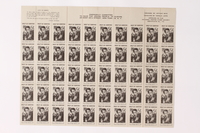
Sheet of US poster stamps encouraging people to donate to a humanitarian organization
Object
Sheet of poster stamps issued in 1944 by the Emergency Committee to Save the Jewish People of Europe. The design was created by the Jewish artist, Arthur Szyk, to develop public interest in the Committee’s humanitarian efforts. Szyk was himself an immigrant born in Łódź, Poland, and lost his mother in the Holocaust. The mission of the Committee was a personal cause for Szyk, and he became one of the founding members. Although they were not valid for postage, poster stamps could be affixed to letters and envelopes as fundraising, propaganda, and educational tools. The Emergency Committee to Save the Jewish People of Europe was founded in 1943 by Peter H. Bergson (pseudonym for Hillel Kook) and other young Jewish activists. The Committee formed in reaction to the first verified information of the Holocaust that reached the United States. On July 20, 1943, the group held the Emergency Conference in New York City, bringing together 1,500 delegates. The Committee was replaced by the American League for a Free Palestine in 1945.
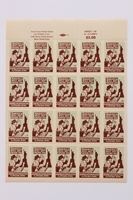
Sheet of US poster stamps addressing Polish Jews
Object
Sheet of poster stamps issued and distributed in 1942 by the American Federation for Polish Jews. Although they were not valid for postage, poster stamps could be affixed to letters and envelopes as fundraising, propaganda, and educational tools. The American Federation for Polish Jews was founded in 1908 in New York City as the Federation of Russian-Polish Hebrews, and changed their name in the 1920s. During the Holocaust, the American Federation coordinated with the World Federation to provide relief and assistance to Jews living in Poland. Despite the promise printed on the stamp to not turn their back on European Jews, the United States government made it increasingly difficult for refugees to enter the country. Prior to entering the war in 1941, the State Department feared infiltration and espionage, and required multiple moral and financial affidavits in addition to a number of other documents for those wishing to enter the country. Additionally, they maintained a strict quota system, which restricted the number of visas granted each year. Fleeing Europe became even more difficult in July 1941, when U.S. consulates closed in Nazi-occupied territories, including Poland.
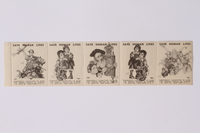
Set of US poster stamps encouraging people to donate to a humanitarian organization
Object
Row of first-issue poster stamps issued and distributed in February 1944 by the Emergency Committee to Save the Jewish People of Europe, to create public interest in their humanitarian efforts. They were created by Jewish artist, Arthur Szyk, and based off his previous works. The first is copied from a 1942 piece entitled “Tears of Rage,” and depicts a soldier angered at the murder and suffering of Jews by the Nazis. The second and fourth designs, featuring two frightened Jewish children, are excerpts from a 1943 piece entitled “To Be Shot, as Dangerous Enemies of the Third Reich…” The fifth design is copied from a 1943 piece entitled “Modern Moses,” and depicts Moses, a role model for the Zionist movement, flanked by a Jewish soldier and industrial worker. All three figures serve as inspiration for American Jews to make their own contributions to the war effort. Szyk was himself an immigrant born in Łódź, Poland, and lost his mother in the Holocaust. The mission of the Committee was a personal cause for Szyk, and he became one of the founding members. Although they were not valid for postage, poster stamps could be affixed to letters and envelopes as fundraising, propaganda, and educational tools. The Emergency Committee to Save the Jewish People of Europe was founded in 1943 by Peter H. Bergson (pseudonym for Hillel Kook) and other Jewish activists. The Committee formed in reaction to the first verified information of the Holocaust that reached the United States. On July 20, 1943, the group held the Emergency Conference in New York City, bringing together 1,500 delegates. The Committee was replaced by the American League for a Free Palestine in 1945.
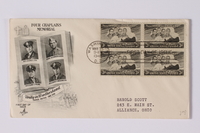
Envelope and stamps commemorating chaplains killed on a ship sunk by a German U-boat
Object
Commemorative envelope and stamps with blank stationery, depicting four United States Army chaplains who died after their ship was sunk by a German U boat. Rabbi Alexander Goode, Reverend George L. Fox, Reverend Clark V. Poling, and Reverend John P. Washington were among the 902 people onboard the Army Transport Dorchester during the early hours of February 3, 1943, when it was fatally hit by a torpedo from a German U boat in the North Atlantic Ocean. The explosion killed and wounded many men, and created chaos amongst the rest. The four chaplains attempted to help and comfort the others aboard, and began distributing lifejackets. When they ran out of lifejackets, the four chaplains gave up their own. As the ship sank, they linked arms and prayed together on the slanting deck. The four chaplains were among the 672 men on the Dorchester who died. They were posthumously awarded with the Distinguished Service Cross, the Purple Heart, and a Special Medal for Heroism, which was equivalent to the Medal of Honor, as men who died in service but not under fire. In 1948, the United States Post Office Department issued a three-cent stamp commemorating the four chaplains.
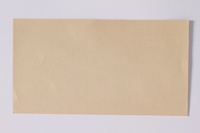
Blank sheet of stationery
Object
Commemorative envelope and stamps with blank stationery, depicting four United States Army chaplains who died after their ship was sunk by a German U boat. Rabbi Alexander Goode, Reverend George L. Fox, Reverend Clark V. Poling, and Reverend John P. Washington were among the 902 people onboard the Army Transport Dorchester during the early hours of February 3, 1943, when it was fatally hit by a torpedo from a German U boat in the North Atlantic Ocean. The explosion killed and wounded many men, and created chaos amongst the rest. The four chaplains attempted to help and comfort the others aboard, and began distributing lifejackets. When they ran out of lifejackets, the four chaplains gave up their own. As the ship sank, they linked arms and prayed together on the slanting deck. The four chaplains were among the 672 men on the Dorchester who died. They were posthumously awarded with the Distinguished Service Cross, the Purple Heart, and a Special Medal for Heroism, which was equivalent to the Medal of Honor, as men who died in service but not under fire. In 1948, the United States Post Office Department issued a three-cent stamp commemorating the four chaplains.
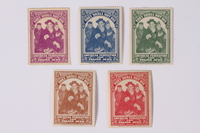
US poster stamp encouraging people to donate to a humanitarian organization
Object
Poster stamp distributed in 1941 by the American Federation for Polish Jews. The design was created by the Jewish artist, Arthur Szyk, used to develop public interest in the Federation’s humanitarian efforts. Szyk was himself an immigrant born in Łódź, Poland, and lost his mother in the Holocaust, making the Federation’s mission a personal cause for him. Although they were not valid for postage, poster stamps could be affixed to letters and envelopes as fundraising, propaganda, and educational tools. The American Federation for Polish Jews was founded in 1908 in New York City as the Federation of Russian-Polish Hebrews, and changed their name in the 1920s. During the Holocaust, the American Federation coordinated with the World Federation to provide relief and assistance to Jews living in Poland.
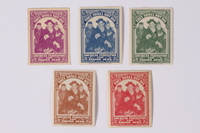
US poster stamp encouraging people to donate to a humanitarian organization
Object
Poster stamp distributed in 1941 by the American Federation for Polish Jews. The design was created by the Jewish artist, Arthur Szyk, used to develop public interest in the Federation’s humanitarian efforts. Szyk was himself an immigrant born in Łódź, Poland, and lost his mother in the Holocaust, making the Federation’s mission a personal cause for him. Although they were not valid for postage, poster stamps could be affixed to letters and envelopes as fundraising, propaganda, and educational tools. The American Federation for Polish Jews was founded in 1908 in New York City as the Federation of Russian-Polish Hebrews, and changed their name in the 1920s. During the Holocaust, the American Federation coordinated with the World Federation to provide relief and assistance to Jews living in Poland.
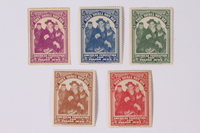
US poster stamp encouraging people to donate to a humanitarian organization
Object
Poster stamp distributed in 1941 by the American Federation for Polish Jews. The design was created by the Jewish artist, Arthur Szyk, used to develop public interest in the Federation’s humanitarian efforts. Szyk was himself an immigrant born in Łódź, Poland, and lost his mother in the Holocaust, making the Federation’s mission a personal cause for him. Although they were not valid for postage, poster stamps could be affixed to letters and envelopes as fundraising, propaganda, and educational tools. The American Federation for Polish Jews was founded in 1908 in New York City as the Federation of Russian-Polish Hebrews, and changed their name in the 1920s. During the Holocaust, the American Federation coordinated with the World Federation to provide relief and assistance to Jews living in Poland.
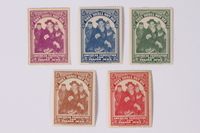
US poster stamp encouraging people to donate to a humanitarian organization
Object
Poster stamp distributed in 1941 by the American Federation for Polish Jews. The design was created by the Jewish artist, Arthur Szyk, used to develop public interest in the Federation’s humanitarian efforts. Szyk was himself an immigrant born in Łódź, Poland, and lost his mother in the Holocaust, making the Federation’s mission a personal cause for him. Although they were not valid for postage, poster stamps could be affixed to letters and envelopes as fundraising, propaganda, and educational tools. The American Federation for Polish Jews was founded in 1908 in New York City as the Federation of Russian-Polish Hebrews, and changed their name in the 1920s. During the Holocaust, the American Federation coordinated with the World Federation to provide relief and assistance to Jews living in Poland.
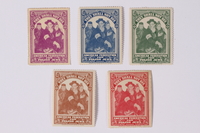
US poster stamp encouraging people to donate to a humanitarian organization
Object
Poster stamp distributed in 1941 by the American Federation for Polish Jews. The design was created by the Jewish artist, Arthur Szyk, used to develop public interest in the Federation’s humanitarian efforts. Szyk was himself an immigrant born in Łódź, Poland, and lost his mother in the Holocaust, making the Federation’s mission a personal cause for him. Although they were not valid for postage, poster stamps could be affixed to letters and envelopes as fundraising, propaganda, and educational tools. The American Federation for Polish Jews was founded in 1908 in New York City as the Federation of Russian-Polish Hebrews, and changed their name in the 1920s. During the Holocaust, the American Federation coordinated with the World Federation to provide relief and assistance to Jews living in Poland.
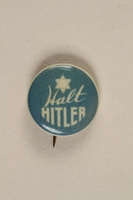
Halt Hitler blue and white anti-Nazi propaganda pin with a Star of David
Object
“Halt Hitler” anti-Nazi pin-back button manufactured during World War II in the United States. In the early 1900s, manufacturers began producing button pins that were used to rally support for a variety of causes. On January 30, 1933, Adolf Hitler was appointed chancellor of Germany, and for the rest of the decade, American newspapers frequently reported on the increasing persecution of Jews and the suppression of their rights. American Jewish leaders employed a variety of overt and behind-the-scenes tactics to encourage the American government to take action, but the majority of citizens opposed allowing refugees into the country. Following the outbreak of World War II in Europe in September 1939, polls suggested that 93 percent of Americans opposed entry of the United States into the war. After the country eventually entered the war in 1941, Americans used a variety of propaganda materials, such as button pins, to support the war effort, but rarely mentioned persecution of Europe’s Jewish population.

Łódź (Litzmannstadt) ghetto scrip, 5 mark coin
Object
5 mark coin issued in the Łódź ghetto in Poland in 1943. Nazi Germany occupied Poland on September 1, 1940; Łódź was renamed Litzmannstadt and annexed to the German Reich. In February, the Germans forcibly relocated the large Jewish population into a sealed ghetto. All currency was confiscated in exchange for Quittungen [receipts] that could be exchanged only in the ghetto. The scrip and tokens were designed by the Judenrat [Jewish Council] and includes traditional Jewish symbols. The Germans closed the ghetto in the summer of 1944 by deporting the residents to concentration camps or killing centers.

Łódź (Litzmannstadt) ghetto scrip, 10 mark coin
Object
10 mark coin issued in the Łódź ghetto in Poland in 1943. Nazi Germany occupied Poland on September 1, 1940; Łódź was renamed Litzmannstadt and annexed to the German Reich. In February, the Germans forcibly relocated the large Jewish population into a sealed ghetto. All currency was confiscated in exchange for Quittungen [receipts] that could be exchanged only in the ghetto. The scrip and tokens were designed by the Judenrat [Jewish Council] and includes traditional Jewish symbols. The Germans closed the ghetto in the summer of 1944 by deporting the residents to concentration camps or killing centers.
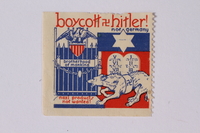
US anti-Nazi boycott stamp with a Star of David, 10 Commandments tablets, and a Nazi dog
Object
Red, white, and blue single poster stamp or sticker issued to promote a boycott of Hitler. It depicts a snarling Nazi dog barred from entering a chained gate marked brotherhood of man, guarded by an American eagle. After Hitler came to power in Germany in January 1933, several organizations in the United States sponsored campaigns urging people to not buy or support Nazi related. Among the groups supporting boycotts of Nazi Germany were the American League for the Defense of Jewish Rights, the Non-Sectarian Anti-Nazi League to Champion Human Rights, and the Joint Boycott Council.
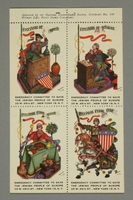
Sheet of US poster stamps depicting the Four Freedoms
Object
Poster stamps distributed in 1944 and 1945 by the Emergency Committee to Save the Jewish People of Europe. The designs were copied from works created in 1942 by Jewish artist, Arthur Szyk, who was inspired by President Roosevelt’s January 1941 State of the Union address (also known as the Four Freedoms Speech). The stamps were used to create public interest in the Committee’s humanitarian efforts. Szyk was himself an immigrant born in Łódź, Poland, and lost his mother in the Holocaust. The mission of the Committee was a personal cause for Szyk, and he was one of the founding members. Although they were not valid for postage, poster stamps could be affixed to letters and envelopes as fund-raising, propaganda, and educational tools. The Emergency Committee to Save the Jewish People of Europe was founded in 1943 by Peter H. Bergson (pseudonym for Hillel Kook) and other Jewish activists. The Committee formed in reaction to the first verified information of the Holocaust that reached the United States. On July 20, 1943, the group held the Emergency Conference in New York City, bringing together 1,500 delegates. The Committee was replaced by the American League for a Free Palestine in 1945.
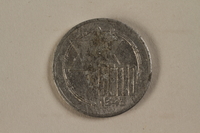
Łódź (Litzmannstadt) ghetto scrip, 5 mark coin
Object
5 mark coin issued in the Łódź ghetto in Poland in 1943. Nazi Germany occupied Poland on September 1, 1940; Łódź was renamed Litzmannstadt and annexed to the German Reich. In February, the Germans forcibly relocated the large Jewish population into a sealed ghetto. All currency was confiscated in exchange for Quittungen [receipts] that could be exchanged only in the ghetto. The scrip and tokens were designed by the Judenrat [Jewish Council] and includes traditional Jewish symbols. The Germans closed the ghetto in the summer of 1944 by deporting the residents to concentration camps or killing centers.
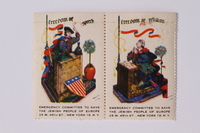
Half a set of US poster stamps depicting the Four Freedoms
Object
Poster stamps distributed in 1944 and 1945 by the Emergency Committee to Save the Jewish People of Europe. The designs were copied from works created in 1942 by Jewish artist, Arthur Szyk, who was inspired by President Roosevelt’s January 1941 State of the Union address (also known as the Four Freedoms Speech). The stamps were used to create public interest in the Committee’s humanitarian efforts. Szyk was himself an immigrant born in Łódź, Poland, and lost his mother in the Holocaust. The mission of the Committee was a personal cause for Szyk, and he was one of the founding members. Although they were not valid for postage, poster stamps could be affixed to letters and envelopes as fundraising, propaganda, and educational tools. The Emergency Committee to Save the Jewish People of Europe was founded in 1943 by Peter H. Bergson (pseudonym for Hillel Kook) and other Jewish activists. The Committee formed in reaction to the first verified information of the Holocaust that reached the United States. On July 20, 1943, the group held the Emergency Conference in New York City, bringing together 1,500 delegates. The Committee was replaced by the American League for a Free Palestine in 1945.
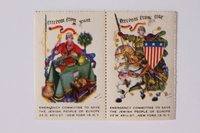
Half a set of US poster stamps depicting the Four Freedoms
Object
Poster stamps distributed in 1944 and 1945 by the Emergency Committee to Save the Jewish People of Europe. The designs were copied from works created in 1942 by Jewish artist, Arthur Szyk, who was inspired by President Roosevelt’s January 1941 State of the Union address (also known as the Four Freedoms Speech). The stamps were used to create public interest in the Committee’s humanitarian efforts. Szyk was himself an immigrant born in Łódź, Poland, and lost his mother in the Holocaust. The mission of the Committee was a personal cause for Szyk, and he was one of the founding members. Although they were not valid for postage, poster stamps could be affixed to letters and envelopes as fundraising, propaganda, and educational tools. The Emergency Committee to Save the Jewish People of Europe was founded in 1943 by Peter H. Bergson (pseudonym for Hillel Kook) and other Jewish activists. The Committee formed in reaction to the first verified information of the Holocaust that reached the United States. On July 20, 1943, the group held the Emergency Conference in New York City, bringing together 1,500 delegates. The Committee was replaced by the American League for a Free Palestine in 1945.
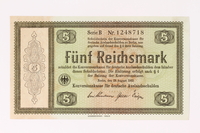
German Konversionskasse scrip, 5 Reichsmark note
Object
Scrip, valued at five Reichsmarks, issued by the Konversionskasse für deutsche Auslandsschulden (Conversion Fund for German Foreign Debts) in 1933. German efforts to finance World War I sent the nation into debt. Following their defeat, the Treaty of Versailles forced Germany to pay reparations to several countries, which increased the nation’s financial struggles. Germany experienced a period of hyperinflation, which was stabilized by the introduction of the Rentenmark in November 1923. Although the economy began to grow again, Germany chose not to tax citizens to fund the reparations, but continued taking out loans from foreign nations, such as the United States. As a result, the repercussions of the Great Depression in America reverberated in the German economy. The Reichsbank began regulating foreign exchange trading in 1931, and took over foreign payment transactions in 1933, with the Konversionskasse serving as an intermediary. The notes were not valid as currency, instead functioning as securities, or an investment in the Konversionskasse. Germany’s continued insolvency and devastated economy allowed the Nazi Party to use people’s fears as a propaganda tool to gain power, eventually leading to Adolf Hitler becoming Chancellor in 1933.
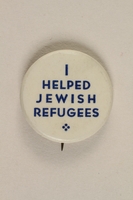
Button pin advertising humanitarian support
Object
“I Helped Jewish Refugees” pin-back button manufactured by the Whitehead & Hoag Company (W&H) in Newark, New Jersey, prior to the United States’ entry into World War II. W&H was incorporated in 1892, and within a few years, acquired three patents for button manufacturing, and became the largest manufacturer of advertising novelties in the United States. Button pins were used to rally support for a variety of causes, and Whitehead & Hoag had clientele from a range of political and ideological beliefs. They became a non-union company in 1919, and produced messaging buttons until the United States entered World War II in December 1941. During the war, W&H refocused their manufacturing to make identification buttons for factory workers. In the decade leading up to World War II, American newspapers frequently reported on Adolf Hitler and the German government’s increasing suppression of Jewish rights and persecution. American Jewish leaders employed a variety of overt and behind-the-scenes tactics to encourage the American government to take action, but the majority of citizens opposed allowing refugees into the country. Following the outbreak of World War II in Europe in September 1939, polls suggested that 93 percent of Americans opposed entry of the United States into the war. After the country eventually entered the war in 1941, Americans used a variety of propaganda materials to support the war effort, but rarely mentioned persecution of Europe’s Jewish population.
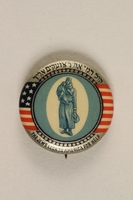
Button pin calling for humanitarian support
Object
Pin-back button, manufactured by the Whitehead & Hoag Company (W&H) in Newark, New Jersey. The central image is based on a 1915 bronze sculpture by Jules Louis (Leon) Butensky titled “Goles” (Yiddish for diaspora) and known as “Exile” in English. Button pins were used to rally support for a variety of causes, and similar buttons were commissioned by the Central Committee for the Relief of Jews Suffering Through the War and for a Relief Ball in March 1916. In the late nineteenth and early twentieth centuries, increased antisemitism, rapid modernization, and deepening economic problems led a large proportion of the Jewish population to emigrate from Eastern Europe. By the time World War I broke out in 1914, Jewish emigres exceeded 3.5 million. Many Jews living in the Austro-Hungarian and Russian Empires in Eastern Europe were displaced due to military campaigns, and fled to other countries to escape persecution. After the war, the United States became increasingly isolationist, with the Quota Act of 1921 and Immigration Act of 1924 severely restricted the number of refugees that could enter the country. In the decade leading up to World War II, Adolf Hitler and the Nazi Party’s increasing persecution and suppression of Jewish rights led more Jews to flee Germany. However, the strict quotas and the growing anti-immigrant sentiment limited the number of Jewish refugees able to immigrate to the United States. Jewish leaders employed a variety of overt and behind-the-scenes tactics to encourage the American government to take action, but the majority of citizens continued to oppose allowing refugees into the country.

Halt Hitler blue and white ant-Nazi propaganda pin with a Star of David
Object
Halt Hitler anti-Nazi pin-back button manufactured during World War II in Canada or the United States.
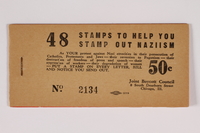
Postage stamp
Object
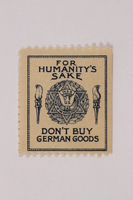
Poster stamp with a printed appeal to not buy Nazi goods
Object
Poster stamps encouraging the boycott of German products, issued by the Jewish War Veterans of the United States (JWV) in May 1933. On January 30, 1933, Adolf Hitler was appointed chancellor of Germany by President Paul von Hindenburg. The Nazi’s increasing targeting of Jews led the small, but militant JWV to hold a parade in New York City and launch the first boycott of German goods in the United States on March 23. Other organizations, including the American Jewish Congress and the American Jewish committee, soon followed with large protest rallies. In reaction to the negative international press on April 1, the German Nazis instigated a one-day nationwide boycott of Jewish businesses and professionals. Soon after, anti-Jewish decrees were passed that restricted every aspect of Jewish life in Germany. On April 10, 1933, the JWV opened a boycott office in New York City, where they printed placards, seals, and letters. The JWV began their stamp campaign on May 21, issuing several million stamps, and estimating that they would continue to send out 10,000,000 a week. The U.S. Post Office banned their use on the exterior of mail—due to their resemblance to postage stamps—so the JWV encouraged their use on the correspondence instead. The boycott movement in America never gained a popular following, and the U.S. Department of State opposed it entirely. By 1941, American enthusiasm for the boycott movement had waned, and the widespread efforts by the larger organizations ceased in October, shortly before the United States entered the war.
Jewish Welfare Fund of Chicago fundraising letter
Document
Contains a fundraising letter on Jewish Welfare Fund of Chicago letterhead; the header reads "Give...or They Die!."
Pamphlet
Object
Brochure printed by Chicago Committee for the Defense of Human Rights Against Naziism.
Poster concerning volunteer solicitation for the aide of Jewish refugees.
Object
Poster concerning volunteer solicitation for the aide of Jewish refugees. (Joint Distribution Committee, United Palestine Appeal, National Refugee Service, Refugee Work in Chicago).
Flier
Object
Pamphlet
Object
Flier
Object
Flier
Object
Pamphlet
Object
Flier
Object
Pamphlet
Object
Book
Object
Forward [Newspaper]
Object
Forward [Newspaper]
Object
Forward [Newspaper]
Object
Forward [Newspaper]
Object
Jewish Community Press [Magazine]
Object
Magazine featuring articles on Hitler, Nazis, and plight of the Jews.
Cover of US poster stamp booklet encouraging people to donate to a humanitarian organization
Object
Cover page for a booklet of poster stamps distributed by the Emergency Committee to Save the Jewish People of Europe. One side features a biography and picture of Arthur Szyk, who was himself an immigrant born in Łódź, Poland, and lost his mother in the Holocaust. The mission of the Committee was a personal cause for Szyk, and he became one of the founding members. Although they were not valid for postage, poster stamps could be affixed to letters and envelopes as fundraising, propaganda, and educational tools. The Emergency Committee to Save the Jewish People of Europe was founded in 1943 by Peter H. Bergson (pseudonym for Hillel Kook) and other Jewish activists. The Committee formed in reaction to the first verified information of the Holocaust that reached the United States. On July 20, 1943, the group held the Emergency Conference in New York City, bringing together 1,500 delegates. The Committee was replaced by the American League for a Free Palestine in 1945.
Articles concerning Palestine, the American Jewish Joint Distribution Committee, and Yad Vashem
Document
Consists of articles from Life magazine and other sources concerning the developments in Palestine after World War II, the execution of Nazi war criminals, and the plight of European children after World War II. Also included are pamphlets relating to the American Jewish Joint Distribution Committee and Yad Vashem.
Forward
Document
Consists of four original issues of the "Forward." The issues are dated 16 Jul 1942, 17Jul 1942, 12 May 1945, and 13 May 1945. Among the topics discussed in the articles are statisticson Jews killed in various concentration camps; the war crimes of Hermann Goering; the destruction of Lidice; Czechoslovakia; and the execution of Jews in the Kraków ghetto.
Hand-colored, antisemitic caricature of a Jewish beggar by Fips
Object
Hand-colored caricature of a Jewish man drawn by Philipp Rupprecht (Fips), and likely cut out from an advertisement for Der Stürmer. Der Stürmer (The Stormtrooper) was a viciously anti-Jewish newspaper published in Germany from 1923-1945 by Julius Streicher, an early Nazi Party member. Der Stürmer thrived on scandal, and published sensational stories of Jews committing disgusting, evil acts. It was also infamous for its antisemitic cartoons created by artists such as Philipp Rupprecht (who used the penname Fips), one of the Nazi’s preeminent propaganda creators. His illustrations portrayed Jews as heartless and cruel, and featured discriminatory images of Jews with exaggerated facial features, and misshapen bodies. Rupprecht also illustrated the antisemitic children’s book Der Giftpilz (The Poisonous Mushroom). Following the end of World War II in 1945, Rupprecht was put on trial and sentenced to ten years of hard labor of which he only served five years.
Satirical postcard featuring Adolf Hitler mailed in the US
Object
Postcard with an image of Adolf Hitler on the front and the caption, "`Quick! Get Cohen my Lawyer."
Hand-colored, antisemitic caricature of a Jewish man by Fips
Object
Hand-colored caricature of a Jewish man drawn by Philipp Rupprecht (Fips), and likely cut out from an advertisement for Der Stürmer. Der Stürmer (The Stormtrooper) was a viciously anti-Jewish newspaper published in Germany from 1923-1945 by Julius Streicher, an early Nazi Party member. Der Stürmer thrived on scandal, and published sensational stories of Jews committing disgusting, evil acts. It was also infamous for its antisemitic cartoons created by artists such as Philipp Rupprecht (who used the penname Fips), one of the Nazi’s preeminent propaganda creators. His illustrations portrayed Jews as heartless and cruel, and featured discriminatory images of Jews with exaggerated facial features, and misshapen bodies. Rupprecht also illustrated the antisemitic children’s book Der Giftpilz (The Poisonous Mushroom). Following the end of World War II in 1945, Rupprecht was put on trial and sentenced to ten years of hard labor of which he only served five years.
"Protest and memorial meeting" letter
Document
Contains a letter regarding a "protest and memorial meeting" sent to Mr. Finkelstein, Executive President of United Brisk Relief Committee from the President of the Jewish People's Committee against Fascism and Anti-Semitism, New York, NY.
Salo Kluger papers
Document
Contains copies of publications and a report from the American Jewish Committee dated 1936 about the situation of European Jewry during the Holocaust and after the 1936 Olympic Games.



